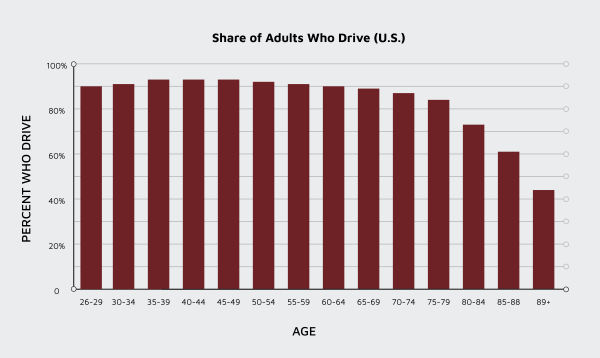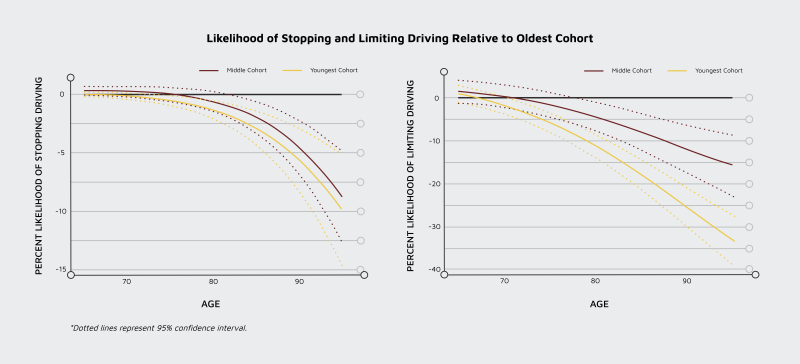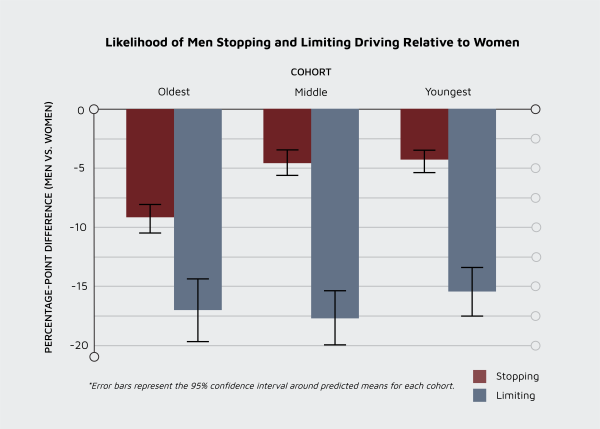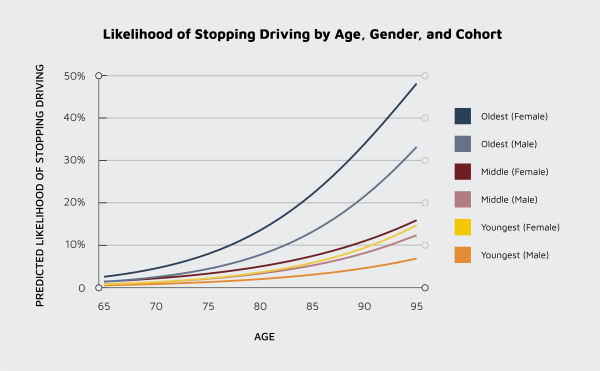
Why Older Adults Stop Driving
Examining the role of age, gender, and birth cohort
Driving is fundamental to quality of life for older adults. Driving lets older adults easily access the places that they need to go to — work, shopping, medical appointments, and social activities. It also gives older adults independent mobility, letting them access these destinations whenever they choose, without relying on family and friends for rides. Given this, many older adults are reluctant to give up the keys to their car, since life for those who do can be difficult: They see fewer people, are less physically active, and become more likely to suffer loneliness or depression.
Because automobility has so many benefits, most older adults — like most younger adults — drive. However, as Figure 1 shows, driving declines with age. The 2017 National Household Travel Survey (NHTS), shows that 82% of adults 65 years and older drove, compared to 92% of 25- to 64-year-olds. Reduced health, cognitive ability, and other factors often force older adults to first limit their driving (e.g., by restricting travel to familiar routes and locations, or to daytime hours) and to eventually give up driving entirely.
Figure 1. Age and Driving, U.S. Adults
This basic relationship between age and driving — older people are less likely to drive than younger people — is not new. Notably, however, the strength of this association has declined over time. For example, about 82% of older adults were drivers in 2017, compared to 77% in 1995. The sheer number of older drivers, furthermore, is growing rapidly. By 2060, nearly a quarter of the U.S. population will be over 65, making it essential that public officials and policymakers understand the travel behavior and driving-related decisions of older adults.
In general, the reasons people limit or stop driving are not surprising: poor vision, as well as serious physical or mental health problems, are among the most common concerns. Somewhat less obvious contributors to driving cessation involve gender (women are more likely to stop or limit driving than men), income (lower-income people are more likely to stop or limit driving than those with higher incomes), and family characteristics (people who live with someone who can give them rides are more likely to stop or limit driving than people who live alone). Because many of these major reasons are correlated with age, older adults are more likely than others to limit or stop driving.

Many older adults are reluctant to give up the keys to their car, since life for those who do can be difficult: They see fewer people, are less physically active, and become more likely to suffer loneliness or depression.

Most of what we know about the driving habits of older adults is drawn from data collected at a single point in time (for instance, the 2017 NHTS). These data leave us unable to answer important questions about how and when people stop driving, particularly about whether driving decisions are shaped by “cohort effects,” experiences shared by people of the same generation. We noted above that older adults are more likely to drive now than they were in the past. There could be multiple reasons for this change, including the role of birth cohorts. It is possible, for example, that people born during a specific time had circumstances and experiences distinct from those born in later decades. They may have been more likely to live in central urban areas, been less reliant on automobiles, and/or have experienced more traditional gendered divisions of labor. These distinct experiences early in life may lead people to make different transportation decisions later in life.
To examine if cohorts matter, we drew on longitudinal data from the University of Michigan Health and Retirement Study (HRS). This study interviews a consistent group of roughly 20,000 people at two-year intervals, allowing us to follow the same people over an extended period of time (from 1996 to 2016). We used these data to examine the likelihood that someone aged 65 or older stopped or limited their driving as they grew older (we defined “limited” as only taking short trips near their home). The data allowed us to compare the likelihood of these transitions for three distinct cohorts: people born in 1923 or earlier, people born between 1924 and 1930, and people born between 1931 and 1941. Because the data set includes information on respondents’ eyesight, physical health, sex, income, family structure, and other issues also associated with driving decisions, we are able to control for many other factors, and can focus on the relationship between age, cohort, and changes in driving.
Recent cohorts of older adults drove longer than earlier cohorts
What did we find? First, and not surprisingly, age matters. As people got older, they were more likely to stop or limit their driving. Holding all other factors constant, an additional year of age was associated with a 10% increase in the likelihood of stopping driving. The relationship between advancing age and limiting driving was similarly positive, but somewhat less pronounced; aging one year was associated with a 5% increase in the tendency to limit driving.
That said, the strength of this relationship has changed over time. Older adults from more recent cohorts were more likely to continue driving, and less likely to limit it. Relative to members of the oldest cohort, members of the cohort born between 1924 and 1930 were 23% less likely to give up driving and 32% less likely to limit their driving. Members of the cohort born between 1931 and 1941 showed an even lower propensity to stop or limit their driving; they were 35% and 49% less likely to stop and limit their driving, respectively, compared to respondents in the oldest cohort.
Figure 2 shows, in percentage terms, how much less likely younger cohorts are, compared to the oldest cohort, to stop or limit their driving as they age (the oldest cohort is represented by the horizontal line at the top of each figure). These findings suggest that the “typical” relationship between age and driving — in which people stop or limit their driving as they become older — has weakened over time. Those who recently entered their 70s and 80s were both less likely to stop driving and less likely to limit their driving than those who entered their 70s and 80s decades ago.
While we don’t know the reasons behind this trend, it may stem from the rapid expansion of automobile-centric infrastructure and automobile access during the postwar period. In contrast to the middle and youngest cohort, the oldest cohort came of age prior to World War II, when licensure rates were lower, automobile ownership was less widespread, and travel by alternative modes was more frequent than in the years following the war. Consequently, members of this oldest group likely had less experience driving and more experience with non-automobile travel during their formative years. These experiences may have led to a weaker reliance on auto travel and more willingness to stop or limit driving as they got older.
Figure 2. Predicted Likelihood of Stopping and Limiting Driving by Cohort
Women were more likely than men to stop and limit driving but the gender gap has narrowed
Driving tends to vary by gender. Women historically were less likely to get driver’s licenses than men, and women, on average, have been more likely than men to stop or limit their driving as they get older. Over time, the licensing gap has declined (and has now disappeared). However, the majority of people in our dataset came of age when these sex-related differences were substantial. With that in mind, we compared the relative likelihood of men and women to stop or limit their driving as they aged, as well as whether gender-related gaps in driving behavior differed across the three birth cohorts.
We found that, overall, gender remained a strong determinant of driving-related behavior. On average, women were far more likely than men to both stop and limit driving. All else equal, across all cohorts, men were 41% less likely to stop driving than female respondents. Patterns were similar for limiting driving, with men being only half as likely as women to limit their driving.
This gender gap, however, has narrowed over time, particularly with regard to stopping driving. As Figure 3 shows, women were still more likely than men to stop driving, but the difference was much less pronounced among younger cohorts. Men in the oldest cohort were about 9 percentage points less likely to stop driving than women in the same cohort. Among members of the middle and youngest cohorts, the male-female gap in driving cessation was substantially smaller, at 4.7- and 4.6-percentage points, respectively.
While the gender gap in driving cessation narrowed over time, the gap in limiting driving was relatively similar regardless of cohort. Men in the oldest, middle, and youngest cohorts were all roughly 15- to 18-percentage points less likely to limit their driving than women. While the reasons behind this persistent gap are likely varied and complex, research suggests that women’s greater willingness to rely on alternatives to driving as well as differing underlying attitudes — in particular, women’s lower levels of confidence when driving — may play a role in explaining continued sex-related differences.
Figure 3. Likelihood of Men Stopping and Limiting Driving Relative to Women
The combined effect of cohort and gender is also of note. It is possible, for example, that the cohort differences illustrated in Figure 2 are largely the result of a shrinking gender gap. In other words, the lower likelihood of stopping driving among the middle and younger cohorts may simply reflect women in these cohorts being less likely than women in previous cohorts to stop driving. Figure 4, however, suggests otherwise: Both gender and cohort predict driving cessation. The influence of these factors is particularly evident when we compare the oldest cohort to the other two: The oldest group has a pronounced gender gap, but both males and females in this group were nevertheless far more likely to stop driving at a given age than those in the middle and youngest cohort.
Differences between the two younger cohorts, in contrast, are far less pronounced. Associations between driving cessation and birth cohort virtually disappear for women in these age groups, as women in the middle and youngest cohort have almost an identical likelihood of stopping driving as they age. For men, a small cohort effect persists, with members of the middle cohort being more likely to quit driving as they age than those in the youngest cohort.
Figure 4: Likelihood of Stopping Driving by Age, Gender, and Cohort
Again, we do not know the underlying reason for these trends. It is likely that attitudes and experiences regarding both gender and driving among the oldest cohort, who largely reached adulthood before World War II, were distinct from those of younger cohorts, who entered adulthood during the postwar period. For example: As automobile use spread during the early 20th century, debates arose regarding whether and to what extent women should drive. Advertisers pitched low-speed, low-range electric cars toward female drivers, viewing the speed and durability of gasoline-powered vehicles as suitable only for men. However, with the growth of suburbs and a steep rise in women’s employment both during and after the war, women became increasingly dependent on car travel to manage both work- and household-related tasks.
It isn’t hard to imagine that these different experiences could matter. Unfortunately, our data do not include information on older adults and their driving histories and experiences, so this is not an idea we can test. However, it is likely that women in the oldest cohort had less driving experience than their younger counterparts. If this was indeed the case, these differing experiences may have led to less reliance on driving among women in the oldest cohort as well as a greater willingness to give up driving as they aged.
Policies to maintain quality of life for older adults
Relationships among driving cessation, aging, and gender are evolving. While age and sex continue to influence driving outcomes in the ways predicted by previous studies, more recent generations of older adults are driving later in life and are less likely to limit their driving to short trips in close proximity to their homes. In our study specifically, we found the largest differences to be between the oldest cohort and the two younger cohorts. We also found that the gender gap in driving cessation persists, but has waned over time.
Three-quarters of older Americans live in low-density suburban or rural areas with few alternative transportation options. Even in dense urban areas, many older adults prefer to travel by car due to difficulty walking, including walking to and from bus stops and transit stations. Driving means retaining functional independence and personal autonomy. This may explain why stopping driving is associated with negative consequences for mental, social and physical well-being — including decreased frequency of leaving one’s home and reduced networks of friends, which can lead to increased depression and accelerated health decline. The benefits of driving must be balanced against safety concerns for the public and for older drivers themselves. Older drivers are more likely to be involved in fatal crashes — crashes that result in at least one fatality — than younger drivers.

The benefits of driving must be balanced against safety concerns for the public and for older drivers themselves. Older drivers are more likely to be involved in fatal crashes — crashes that result in at least one fatality — than younger drivers.

To balance the benefits and costs associated with older adult driving, we suggest three specific policy approaches.
First, if older adults continue to drive as they age, policymakers must target automobile and road safety improvements to this growing segment of the population. These interventions could include continued improvements in advanced vehicle technologies, such as rear and side cameras, automatic braking systems, and lane-departure warnings. Targeted efforts to encourage adoption of these technologies by automakers and assistance for older drivers in purchasing such vehicles could improve both mobility and safety.
Second, policymakers should expand access to services that provide automobility without driving (such as carpooling or ride-hail). Simply expanding access, however, may not be enough. Older adults often have difficulty using these services, and in particular may need help booking rides.
Finally, some older adults who live in dense urban areas that are safe and clean could forfeit driving and instead walk to transit stops and stations or to their destinations. Policies aimed at making urban environments more amenable to the non-automotive travel of older adults could reduce car use without sacrificing quality of life.

This article and research would not have been possible without the contributions of Martin Wachs, whose illustrious academic career included more than 50 years of scholarship around older adults and aging.



